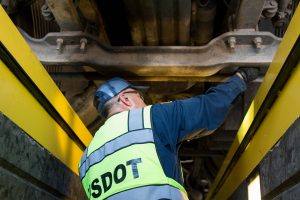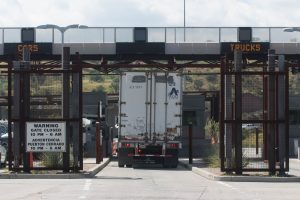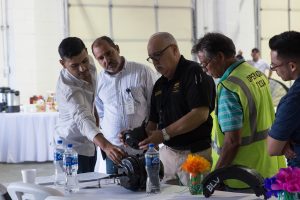- Slug: BC-CNS-Trucker Safety,1000
- Photos available (thumbnails, captions below)
- Video story available
- Graphic available (embed code below)
By SAMANTHA POULS and JACKIE LOPEZ
Cronkite News
NOGALES, Mexico – Sixty truck drivers scribbled notes in a Mexican warehouse last month as they listened to a United States border inspection officer describe the types of things officers examine during border inspections.
Flat tires. Broken headlights. Cargo that’s not secured.
The group gathered as part of a new program the Arizona Department of Transportation launched earlier this year to help train truck drivers entering the U.S. from Mexico to quickly pass safety inspections. The free two-day course became so popular, the department added more classes.
Miguel Ramirez, a Mexican truck driver with more than 20 years of experience, attended the class. He said before the International Border Inspection Qualification Program launched, drivers often faced problems when they tried to cross the border.
“For example, a lot of times, we would enter with a flat tire, or I don’t know, we would be missing a pin or a cap screw,” Ramirez said in Spanish. “We wouldn’t secure the load properly.”
George Hammond, director and research professor at University of Arizona’s Eller College of Management, said more than 400,000 trucks crossed through Arizona border points in 2016. This is a 3.3 percent increase from 2015, mostly because of a jump in produce brought into the state from Mexico.
Yet, ADOT officials said the crossing wasn’t always smooth.
“They were having some difficulties getting across the border, with inspection issues, fines and other reasons,” ADOT Director John Halikowski said. “We’ve been looking for ways to make that crossing more efficient because it’s important not only for safety, but also for the economies of both Arizona (and) Sonora.”
Imports on the Arizona-Mexico border totaled about $18.26 billion in 2016, according to data from the University of Arizona Eller College of Management.
Drivers entering from Mexico used to have to drop their cargo at warehouses near the border. But regulations now allow them to travel beyond those border zones, according to the U.S. Department of Transportation. To do so, they must register, undergo an inspection and reapply every 18 months.
But all commercial trucks entering the U.S. must go through an inspection when they cross. Arizona’s Border Liaison Unit conducts the safety inspections, and the U.S Customs and Border Patrol checks the cargo, according to an ADOT news release. ADOT officials work alongside the Federal Motor Carrier Safety Administration to ensure that truck inspections meet both state and federal standards.
Martha Rascon Overpeck, executive director of the Safe Border Trucking Association, said inspections on the Mexico side are not as strict as in the U.S.
Lt. John Doepadre of the Nogales Port of Entry said Mexican truck drivers often don’t have the right documentation.
“We even had drivers who tried to come across who didn’t even have the proper driver’s license for commercial,” Doepadre said.
The classes teach the truckers what to expect. Ramirez said drivers often didn’t know why inspectors looked at their trucks in the first place.
“Maybe they believed the officials did it with wrong intentions,” Ramirez said. “But no, when you come here, and you find out what the officials base their inspections, violation tickets or penalties, you understand that what they say is correct.”
After completing the program, truckers receive a certification sticker they can post on the side of their truck.
“The sticker alerts inspectors that this is a truck operated by someone who has passed our class,” ADOT spokesman Tom Herrmann said. “So we can do a walk around of that truck, just to make sure everything looks right, but we start out with the thought that this truck will probably be safe given its history.”
Truckers also can access the WhatsApp messaging application, which allows drivers to communicate with inspectors. They can send photos of potential safety hazards or ask questions regarding their truck, and they can fix problems before traveling to the border.
In addition to training truckers, ADOT officials also worked with inspection officials to ensure consistency. Officials noticed some commercial trucking companies sent their drivers through California or Texas – even if Arizona was a more direct option – to avoid the inspection process here, according to a news release.
“We were losing some business to Calexico, California. Truck drivers were choosing to go to other places because the inspections were more consistent,” Herrmann said.
ADOT officials often kept truckers at inspection points until the truck met safety inspection protocols.
“If they have to sit here and be repaired, it can be two, three, four hours,” he said. “They might have to wait for their mechanic to cross the border, or they’ll have to pay an American company at a potentially higher rate. They want to be able to do their repairs on their property, save time, save money.”
Herrmann said the additional training should help.
“We’ve trained our inspectors so that if you go to Douglas, if you go to San Luis, if you go to Nogales, you get the same inspection,” Herrmann said. “Now we’re trying to make it so that we can bring the business across the border, and Arizona gets the business.”
Herrmann said Arizona warehouses that store cargo directly benefit from truckers crossing into the state. Additionally, truckers often stop at Arizona hotels and restaurants.
“We are connected to the world through these points of entry,” Halikowski said. “Product goes in and it goes out, and that means more people are working.”
The training program for truckers began in late April with four sessions, but ADOT added four more sessions. The next session will take place on Oct. 10-11 in Hermosillo, Sonora, Mexico.
^__=






^__=
Embed code: